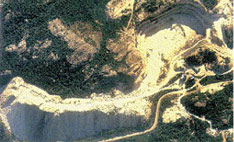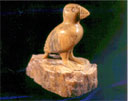Continuing the Long Tradition of Mining on the Avalon Peninsula
(by John Hayes, from Mining Week supplement to Robinson-Blackmore newspapers, 1994)

The Avalon Peninsula has a long history of mining activity. Most people are familiar with the Bell Island iron mines, but few are aware that there is a small mine near Manuels, Conception Bay, which has been around for about the same length of time. It is locally known as the Talc Mine although the mineral of interest is actually pyrophyllite. Pyrophyllite has a different chemical composition from talc but the two minerals have some properties in common, such as softness and a light colour. These similarities in properties were probably why Frederick Andrews, the original developer, called it the Talc Mine.
Mr. Andrews acquired the property in 1902 and put it into production in 1904. An aerial tramway to the nearby railway and dock facilities at Seal Cove was constructed, but the company went bankrupt in 1906. Mr. R. K. Bishop, of St. John’s, subsequently reopened the mine in 1909, but it closed again in 1910. The earliest production came from small quarries on the sides of Mine Hill, a prominent ridge near the present-day operations. The early workings can still be seen and some pods of pyrophyllite are visible near the workings. The deposits on Mine Hill were probably mined first because they were the easiest to quarry. However, the best quality deposits were not developed until 1938 when the Industrial Minerals Company of Newfoundland Limited started mining at the present site. They shipped to the United Kingdom, the United States and Canada until the mine closed in 1947.
The Newfoundland government assumed control of the property under the Undeveloped Mineral Area Act of 1952. It was reopened in 1956 by Newfoundland Minerals Limited, a subsidiary of a company that later became the American Olean Tile Company. A geological report written at about this time concluded that there was a deposit of 1.5 million tons of ore to a depth of 300 feet below the surface. At the rate of 10,000 tons-a-year production in the 1950’s, it would be operating for 150 years! Historically, the mining rate has actually been about 40,000 tons per year. However, subsequent exploration drilling has added to the reserve estimates projecting its operation well into the 21st century. The mine is owned and operated today by Armstrong World Industries Canada Limited.

The present-day operation is vastly different from the early operations. Most of the early works were aimed at mining pure pyrophyllite instead of the pyrophyllite-bearing rock that is mined today. The blasted mineral is sorted visually such that the ore is separated from the waste and taken to the crusher. Samples of the crushed rock are taken and analyzed. The crushed ore is blended to meet the manufacturer’s specifications and is shipped by boat to the USA, where it is used to make high quality ceramic tiles. The soft pyrophyllite also makes a good carving stone. You can find pyrophyllite carvings and engraved polished slabs of pyrophyllite at local craft shops and shows, as in the example on the right.
You might be wondering why pyrophyllite occurs in the Manuels area. Pyrophyllite forms when hot fluids from deep in the earth come into contact with volcanic rocks. The volcanic rock is chemically transformed into pyrophyllite. The hot fluids can also carry other metals such as gold and copper (the gold deposit at Hope Brook in southern Newfoundland formed this way). Because the Manuels deposits occur in volcanic rocks that are similar to rocks in other areas which host gold deposits, geologists and prospectors have been searching for gold in the Manuels area. Sampling done by prospectors and the Department of Natural Resources indicate some gold anomalies. The mineral claims map for the area shows a number of claims staked for gold surrounding the original mining lease bearing the name of Frederick Andrews. The mining history of the Avalon Peninsula may be far from over.
